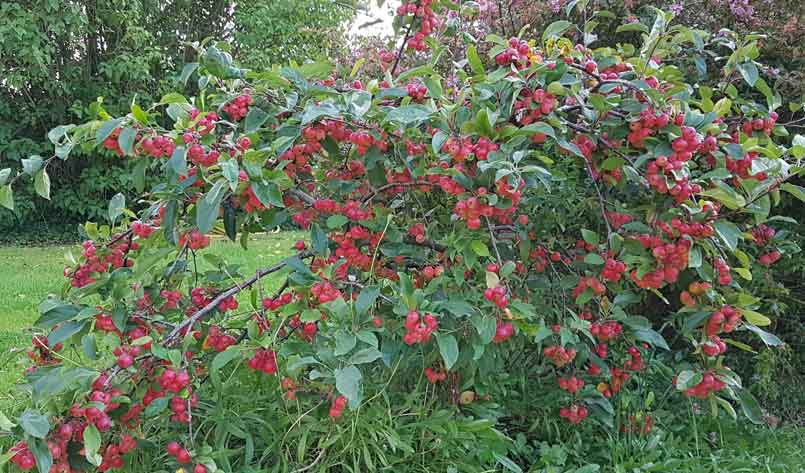
Patio Trees – A tree for any size of garden
Patio trees, as the name suggests, are small trees that are suitable for growing in smallest of gardens. They can also provide a large garden with an attractive specimen plant in a pot, for example, a crab apple tree with blossom in spring followed by fruits and autumn colour. Patio trees are ‘grafted’ onto ‘dwarfing rootstocks’ that stop them growing tall. A collection of fruiting and ornamental patio trees can provide interest with different blossom, fruit, berries, shapes and textures, with the plants all growing to a similar height. If your space is temporary, they can move with you.
Patio Fruit Trees
A ‘Potted Orchard’ gives a good harvest from many varieties of apples, pears and cherries, including ones you would expect to be a full-sized tree, such as ‘Bramley’s Seedling’. Fan-trained or espalier trees can be trained on south or west-facing walls and fences and borders.
The more unusual trees such as Walnut, Hazel and Cobnut grow well in our climate and need no pruning. Mirabelles and Mulberries produce interesting, bountiful, mid-summer fruits for eating or preserving. Quinces and Medlars are spring-flowering fruits for culinary use – they also have good autumn colour.
Patio Ornamental Trees
Ornamental patio trees include Cotoneaster ‘Juliette’, a weeping tree with orange berries in autumn. We also have different varieties of patio crab apples including the golden Malus ‘Butterball’ and the red ‘Red Sentinel’. Flowering cherries such as Prunus ‘Little Pink Perfection’ have beautiful double-pink blossom in spring.
Acer palmatum (Japanese Maples) are slow-growing small trees that can be grown in large pots or containers. They are grown for their beautiful leaf shape and colours. Many varieties will grow to 15ft (5m) but they can be kept pruned in winter (or even Bonsai-ed). The ‘Dissectum’ maples naturally grow in a dome or umbrella shape with a dissected or lace-like leaf texture. These only grow 5 or 6ft tall (up to 2m) and need no pruning. We have one in a pot on the nursery that is 35 years old.
Japanese Maples will grow in sun or shade with the red and purple-leaved varieties needing some sun to show their colours. The most important thing is to protect them from wind, especially in early spring when their new leaves are emerging.
Looking after your Patio Tree
Patio trees can be grown in the ground or a pot. If you are growing in a pot, it is best to choose a large pot that suits your style and the eventual look of your garden. It is best to sit them on ‘pot feet’ in the winter to allow extra drainage in frosty conditions.
We recommend a loam-based compost such as John Innes No.3, this will mean your tree doesn’t dry out so quickly. Some of the Acers prefer a slightly acid compost so mixing John Innes No.3 compost with ericaceous compost is a good idea.
Feed every March with Osmocote slow-release fertiliser to ensure good healthy growth for the coming season. See our £5 off voucher on a patio tree in October for Greenshutters Garden Club Members. Not a member? Ask to join, it’s free![/vc_column_text][/vc_column][/vc_row]


